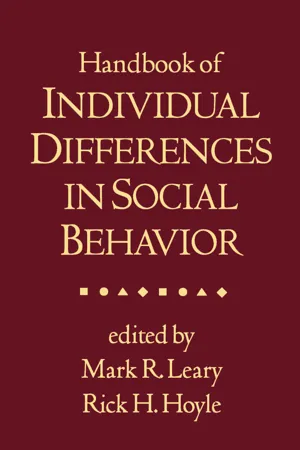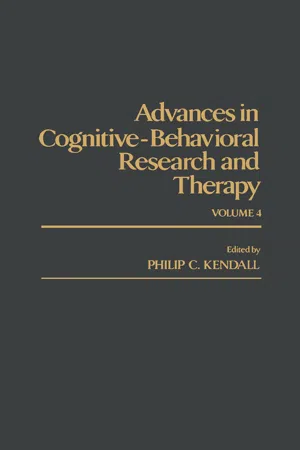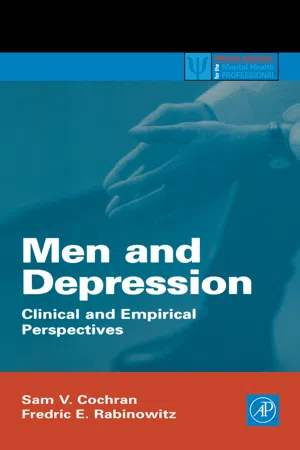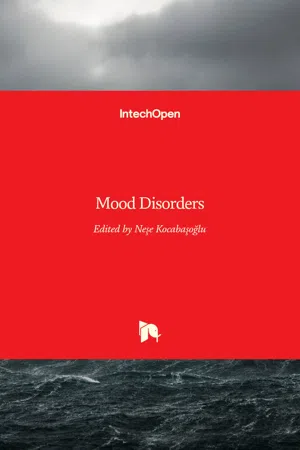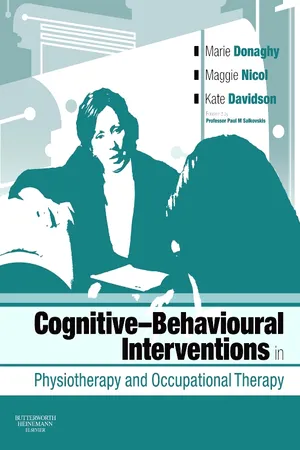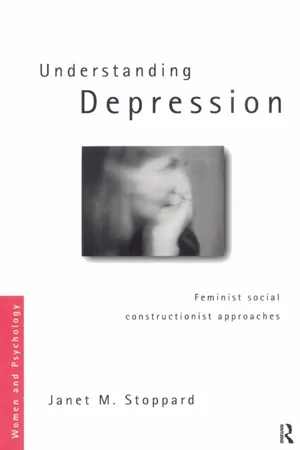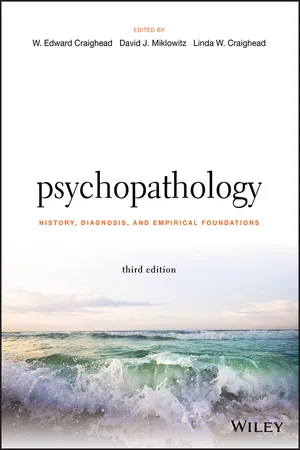Psychology
Theories of Depression
Theories of depression in psychology encompass various perspectives on the causes and mechanisms of depression. These theories include biological, cognitive, behavioral, and psychodynamic explanations. Biological theories focus on genetic, neurological, and biochemical factors, while cognitive theories emphasize distorted thinking patterns. Behavioral theories highlight the role of environmental triggers, and psychodynamic theories explore the influence of early experiences and unconscious processes.
Written by Perlego with AI-assistance
Related key terms
1 of 5
12 Key excerpts on "Theories of Depression"
- eBook - ePub
- Mark Mays, James W. Croake, Mark Mays, James W. Croake(Authors)
- 2013(Publication Date)
- Routledge(Publisher)
3 Theories of DepressionTreatment in the managed care environment requires specific knowledge about the conditions the provider is treating. Treatment planning is the core of managed care. With respect to depression, the therapist is fortunate, since there is no shortage of theories intended to illuminate and explain it. Theories range widely: from those that emphasize the biological underpinnings of depression to those mat focus on its social context, from those that look at behaviors to those that explore phenomenology or emotional experience, from the old to the new, and from the more simple to the ornately complex.Theories of Depression also vary in terms of the research supporting them. Within the social and medical sciences, empirical research has always been a way to validate theoretical understanding. Some theories, by their nature, lend themselves less well than others to empirical validation or refutation. Psychoanalytic theory is one of these. Other theories may be open to empirical inquiry, but practical considerations may constrain research efforts. For example, longitudinal research is expensive, and funding is often hard to obtain for studies that will not bear fruit for years, if at all. Theories that could be investigated by life-span research, therefore, will probably not be explored empirically. Funding for studies of drug effectiveness, relevant to certain biological theories, on the other hand, might be more available from the pharmaceutical companies that produce the antidepressant medicines being investigated. In short, there is hardly a consensus on the causes of depression, and the validation for the various views is often wanting.Biological TheoriesTheories of Depression can be easily divided into those that refer to biological causes and those that refer to psychological causes. Biological theories may well be historically the most accepted, and they have strong currency today. A review article by Lewis (1967) about melancholia notes that even Hippocrates proposed a biological basis for melancholia. He believed that the accumulation of “black bile and phlegm” affected one’s mood state, “darkening the spirit and making it melancholic.” - Mark R. Leary, Rick H. Hoyle, Mark R. Leary, Rick H. Hoyle(Authors)
- 2013(Publication Date)
- The Guilford Press(Publisher)
161 P sychological Theories of Depression have broadened our understanding of the various situational contexts and individual vulnerabilities that appear to precipitate de- pressive episodes. Yet the factors involved in the development of depression and its main- tenance long after the original impetus has passed are a source of continued debate. As we discuss in this chapter, research has been able to pinpoint certain attributional styles, environmental contexts, and physical condi- tions that give rise to depressive symptoms. Despite these advances, the primary conun- drum of research on depression remains the pursuit of explanations of why depression initially develops, why it continues for some, and why others are resilient in the face of life stress. A key issue in the psychological litera- ture on depression is its operationalization in research studies, the methods available for measuring depression, and how these measurement approaches have been imple- mented in empirical studies. We begin this chapter, then, by presenting an overview of the methods found to be most useful in iden- tifying and diagnosing depression. Next, we highlight several of the most prominent psychological Theories of Depression that, we hope, capture the essence of how depression both differentiates people and, in turn, is differentiated by social, cognitive, and psy- chophysiological factors. Finally, we discuss recent research on resilience factors that distinguish people with little to no history of depression from individuals who become recurrently or chronically depressed. Measuring Depression Two of the most widely used types of depres- sion measures are diagnostic classification measures and depressive symptom severity scales (Nezu, Nezu, McClure, & Zwick, 2002). Measures used for diagnostic classifi- cation involve semistructured or structured diagnostic interviews.- eBook - ePub
Depression
Causes and Treatment
- Aaron T. Beck, M.D., Brad A. Alford, Ph.D.(Authors)
- 2014(Publication Date)
- University of Pennsylvania Press(Publisher)
Part III Theoretical Aspects ofDepressionPassage contains an image Chapter 11 Theories of Depression
The Theories of Depression that have been most tested and applied to the psychotherapeutic treatment of the mood disorders include the interpersonal and cognitive behavioral formulations.1 Other theories include Freud’s psychoanalytic theory, evolutionary theories, existentialism, neurological and neuropsychological perspectives, biochemical theory, and animal models.Behavioral TheoriesSeveral behavioral Theories of Depression have been advanced. Among the early theorists in this area were Ferster,2 Seligman,3 ,4and Lewinsohn.5Seligman suggested that the phenomenon of “learned helplessness” in animal models might be meaningfully analogous to clinical depression in humans. Briefly, Seligman found that when a normal dog receives escape-avoidance training, it quickly learns to avoid a shock by moving to the safe side of a shuttle box. However, dogs given inescapable shocks before avoidance training were found to act quite differently. Instead of attempting to escape, such dogs would give up and passively accept the shock.Seligman reviewed similar studies with a variety of animals and concluded that learned helplessness is found in “rats, cats, dogs, fish, mice, and men” (p. 86).4 Based on this generalization, he theorized a specific arrangement of reinforcement contingency, that is, inescapable punishment, could be a causative factor in the lives of those who become clinically depressed.Ferster and Lewinsohn likewise referred to basic behavioral principles to account for clinical depression. Ferster theorized that depression may be a reduced frequency of “adjustive behavior,” or behavior that maximizes reinforcing outcomes. Put simply, the depressed person increases avoidance and escape behavior in situations where it is possible to obtain positive reinforcement, and conversely develops a passive behavioral repertoire in circumstances where escape would be reinforcing, thus (as in the “learned helplessness” model) failing to escape punishment. - eBook - PDF
- Philip C. Kendall(Author)
- 2013(Publication Date)
- Academic Press(Publisher)
VI. CONCLUSION This review has attempted to analyze and update three major con-temporary psychological approaches to depression which emphasize cognitive variables as mediators of depressive reactions. Their contri-butions have greatly expanded our knowledge of and interest in this most common of major psychiatric complaints, and their limitations as discussed in this article are instructive for the future development of this field. Doubtless there will continue to be theories that aim to ac-count for depression in a single theoretical position, but the implica-tion of this review is that only multifaceted models can hope to capture the complexity of depressive phenomena. While we may currently lack the tools and concepts to develop complete models, a cognitive-behav-ioral approach to the study of person-environment interactions prom-ises important achievements. In the final analysis, however, the goal of complete predictability of depression construed as a single entity seems unrealistic. There are too many important and dynamically in- 66 Constance L. Hammen REFERENCES Abramson, L., Seligman, M., & Teasdale, J. (1978). Learned helplessness in humans: Critique and reformulation. Journal of Abnormal Psychology, 87, 4 9 -7 4 . Alloy, L., & Abramson, L. (1979). Judgment of contingency in depressed and non-depressed students: Sadder but wiser? Journal of Experimental Psychology: Gener-al, 108, 4 4 1 -4 8 5 . Alloy, L., & Abramson, L. (1981). Depression, nondepression, and cognitive illusions. Paper presented at the annual meetings of the American Psychological Association, Los Angeles. Arieti, S., & Bemporad J. (1980). The psychological organization of depression. American Journal of Psychiatry, 137, 1 3 6 0 -1 3 6 5 . Bandura, A. (1978). The self-system in reciprocal determinism. American Psychologist, 33, 3 4 4 -3 5 8 . Barthé, D., & Hammen, C. (1981). A naturalistic extension of the attributional model of depression. - eBook - ePub
Stress and Your Health
From Vulnerability to Resilience
- Hymie Anisman(Author)
- 2015(Publication Date)
- Wiley-Blackwell(Publisher)
Several theoretical perspectives have been offered to account for the development of depression. Some of these, such as psychoanalytic theories, have largely dropped by the wayside, being replaced with either cognitive models of depression or those that involve biochemical and/or genetic explanations. According to cognitive models, depression arises as a result of disturbed or negative ways that individuals think about themselves, whereas the neurochemical explanations of depression assert that changes of hormones, growth factors or neurotransmitters are responsible for the development of depressive disorders. Of course, the two may go hand-in-hand, as neurochemical changes might promote the cognitive disturbances, which can further exacerbate the biological disturbances.Helplessness
It might be recalled that Seligman and his associates suggested that when animals or humans encounter uncontrollable stressful situations they learn that they have no control over their destiny, essentially being “helpless” in determining events. If these cognitions persist and are strong enough, individuals might fall into a state of depression. These feelings and cognitions would not only be accompanied by a failure of the individual to make efforts to alter their destinies, but responses to positive or rewarding events would be altered as well. This is reminiscent of the negative biases that depressed individuals display when they encounter difficulty in achieving goals (“I can try to do what’s required, but I know that it just won’t work out”), and may encourage anhedonia in which the rewarding value of stimuli and events is diminished. Of course, the helplessness expressed by depressed patients might be a feature of their illness, rather than being a causal factor, but the helplessness view is intuitively appealing and was widely adopted as being responsible for the development of the illness.Although most people, at one time or another, encounter stressful events over which they might not have control, only a modest proportion actually become clinically depressed. What is it about some individuals that makes them vulnerable to psychopathology, whereas others escape relatively unscathed? Helplessness theorists suggested that the specific attributions formed regarding failure or stressor experiences were fundamental in determining the development of cognitive disturbances. When individuals fail in reaching their goals they might ask themselves why this occurred, and their specific attributional style may have a lot to do with their propensity for depression. Individuals differ on three appraisal (attribution) dimensions that in particular combinations would favor the emergence of helplessness and hence depression. They can make internal attributions (“I’m not very good at stuff related to computers”) or external attributions (“I might not be very good at computer stuff, but who could work in that noisy environment?”); the attributions can be stable or unstable (“I’m never any good with computers and never will be” versus “at times, I’m not very good with computers, but it depends on a bunch of things”); the attributions can also be either global or specific (“I’m neither good with computers, nor any of the other new-fangled stuff” versus “I’m not very good at anything that has to do with computers, but I’m fine with other things”). If they are the type who makes internal, stable, global attributions regarding their inabilities, they will develop negative expectations of the future, coupled with feelings of inadequacy and poor self-esteem, culminating in feelings of helplessness, which encourages depressive disorders. It’s fine to make assertions regarding the link between attributional style and the development of depression, but we might also want to know how these dysfunctional ways of thinking evolved. As we’ve already seen, many factors that influence our stress responses, including early experiences, genetic dispositions, and several personality variables, might play into this cognitive mindset. - eBook - PDF
Men and Depression
Clinical and Empirical Perspectives
- Sam V. Cochran, Fredric E. Rabinowitz(Authors)
- 1999(Publication Date)
- Academic Press(Publisher)
Cognitive Models of Depression Cognitive models of depressive disorders have been both descriptive and explanatory. These models have led to many advances in understanding depression, as well as to effective treatments for depression. Beck and his colleagues (Beck, 1976; Beck, Rush, Shaw, & Emery, 1979; Newman & Beck, 1990) have been prominent in formulating cognitive models of depression. In this model, a set of information processing biases or inter- nal mental representations are believed to determine how a person sees the self, his or her life circumstances, and the future. These information processing biases are called schemas. In depressed individuals, Beck and his colleagues propose that a cognitive triad of schemas exists that pro- duces negative views of the self, the person's personal world, and the person's beliefs about the future. These schemas related to self, world, and future are consistently present in depressed individuals and con- tribute to the development and maintenance of depressed mood. The 38 Men and Depression significance of altering these negative cognitions and the impact on mood and behavior has also been documented in studies of the impact of cognitive psychotherapy. The cognitive model of depression has also led to an expansion of research on cognitive mediated models of affec- rive disorder and depression (e.g., Gotlib & Hammen, 1992). This cognitive perspective on mental functioning and the influence of thinking on mood has spawned a number of theories about depres- sion. An important development in this area is the study of the way individuals explain to themselves the circumstances and events of their lives. Seligman and his colleagues originally formulated a learned helplessness model of depression that was based on behavioral animal studies (Seligman, 1975). Later elaborations of this model included a cognitive component, the attribution reformulation (Peterson & Selig- man, 1984). - eBook - PDF
- Nese Kocabasoglu(Author)
- 2013(Publication Date)
- IntechOpen(Publisher)
Detailed discussion of these factors would certainly exceed the scope of the present chapter; therefore, in this section we focus primarily on the three psychological genera‐ tion models as these are mainly relevant for behavior-therapeutic treatment. Cognitive Behavioral Therapy (CBT) of Depressive Disorders http://dx.doi.org/10.5772/54200 69 The hypothetic causes of generation and maintenance of a depressive syndrome that can be effectively treated with behavioral therapy are linked either to the behavior or the cognition of the patient. 7.1. Cognitive models 7.1.1. Cognition-theoretical explanation model according to Beck According to the cognition-theoretical explanation, the basis of each depressive devel‐ opment is represented primarily by cognitive dysfunction; the thinking pattern of the depressed patient is characterized by logical errors such as selective perception, ran‐ dom drawing of conclusions, exaggerations, etc. Negative, burdensome life experien‐ ces, which manifest themselves as cognitive schemes, are triggering conditions leading to dysfunction by developing a set of negative perceptions (also called cognitive tri‐ ads”; [77]) regarding the • identity (I am of no worth) • environment (nobody loves me; everybody is against me) • future (there is no point, nothing will improve). The cognitive triad forces the depressed individual to deal with irrational negative thoughts that are plausible to him/her over and over again. The patient experiences these thoughts as being automatic, intractable, persistent and unintended. Such thoughts are always about topics such as hopelessness, low self-esteem or suicide. Beck holds this cognitive disorder responsible for all psychiatric features of depression. Depressed indi‐ viduals usually aim very high and believe that the world always imposes insurmounta‐ ble obstacles for them. They tend to make their own deficits or low level of ability responsible for unpleasant experiences. - eBook - ePub
- J. Mark G. Williams(Author)
- 2013(Publication Date)
- Routledge(Publisher)
Chapter 10
The cognitive theory of depression revisited
Although it was not until the late 1960s and 1970s that experimental clinical psychologists started seriously to develop theories about the onset and maintenance of depression, even from these early theoretical writings there emerged a controversy about the necessity to postulate cognitive mediators. There are two forms of this debate, the first, with which we shall not be concerned here, is the philosophico-theoretical issue about the status of ‘private events’ and their explanatory power.The other debate is that between those who believe that cognitive events precede and cause the emotional disturbance, and those who believe that the emotional disturbance can be explained on other grounds (biological or behavioural) and see cognitive distortions and negative self-talk as a product or correlate of the emotional disturbance.Now this debate is crucial. If cognitive events are an epiphenomenon, accompanying though not playing a causal role in affective disorders, it would make less sense to devote years of research to how best to change cognitive styles or habitual self-talk strategies. Like ointment on a chickenpox rash, such treatment may soothe but have little prospect of treating the underlying disorder. Of course cognitive therapies do work (see Chapter Four ) but it may be that they are inadvertently affecting other more significant subsystems. Let us then examine the status of the aetiological cognitive thesis.Just to complicate matters further there are also two forms of the aetiological thesis. Let us call them the ‘precipitation theory’ and the ‘vulnerability theory’. The first is a ‘state’ theory and argues that moment-tomoment fluctuations in mood may in part be accounted for by the thoughts, images, and memories that occur to the individual. Controlling the nature, frequency or intensity of these thoughts and images will thereby affect the mood that is consequent upon them. The vulnerability theory argues that long-lasting styles of thinking (e.g. attributional style, tendency to selectively abstract or think dichotomously) occur prior to and render a person vulnerable to depressive breakdown in the face of stress. Although often confused under the general title of cognitive theory of depression, these theories are quite distinct and ought to be discussed separately. We shall consider the evidence for each in turn. - Marie Donaghy, Maggie Nicol, Kate M. Davidson(Authors)
- 2008(Publication Date)
- Butterworth-Heinemann(Publisher)
It is probably less clear how the more biological symptoms of depression such as loss of appetite, libido and sleep disturbance directly relate to the cognitive triad other than through a more complex relationship between thinking and biochemical and physiological events with each having an influence on the other (see Chapter 3 for a fuller discussion). Cognitive processing The content of the negative automatic thoughts of depressed patients is biased in specific ways. Five types of errors have been identified as being characteristic of information processing in depression. Blackburn & Eunson (1988) analysed the content of 50 depressed patients’ thoughts and found that the errors shown in Table 1.2 accounted for the cognitive processes in depression. Some thoughts can be classified under more than one type of error. The most common error is selective abstraction. Schemata These are stable knowledge structures representing all the knowledge an individual has of self and the world. As seen in the cognitive model of depression, an indi- vidual’s earlier experiences may contribute to a vulnerability to depression that is triggered by a stressful life event. Depressogenic schemas will usually be concerned with themes of loss, worthlessness, defeat and deprivation. When activated these depressogenic schemas will bias and distort information, and as a consequence, will lead to other symptoms of depression. Beck (1967) considered the activation of the schemas as being the mechanism by which depression develops, though the cause of depression may be multifaceted and include biological, developmental, environ- mental genetic and cognitive factors. 9 Cognitive–behavioural therapy: origins and developments Main characteristics of cognitive–behavioural therapy Cognitive therapy is a structured, short-term therapy based on a thorough under- standing of the specific disorder being treated and how the disorder has affected the patient.- eBook - ePub
Understanding Depression
Feminist Social Constructionist Approaches
- Janet Stoppard(Author)
- 2014(Publication Date)
- Routledge(Publisher)
The work of Beck (1991) is most closely associated with this approach. According to the cognitive model proposed by Beck and his collaborators (Beck et al. 1979), individuals who become depressed are characterized by a distinctive cognitive style (or way of thinking) in which negative interpretations of their experiences tend to predominate. This tendency toward cognitive negativity encompasses individuals’ interpretations of their past and current experiences as well as their expectations for the future. According to this cognitive formulation, depressed individuals are characterized by a style of information processing which leads to a negative, pessimistic outlook. Cognitive therapy is an approach to treatment of depressed individuals based on this cognitive theory of depression. Cognitive theory of depression has undergone further refinements in recent years to address the issue of why some people but not others become depressed. There is abundant evidence that when individuals are depressed, their thinking is dominated by negative, pessimistic thoughts (Coyne 1994). However, evidence has not been forthcoming that this distinctive thinking style is also present when these same individuals are not depressed (Clark and Steer 1996). Cognitive theorists now postulate instead that individuals prone to depression are characterized by personality traits which predispose them to becoming depressed (Beck 1996, Clark and Steer 1996). These personality “orientations” or “modes” are not simply triggered by a depressive state, but are presumed to exist before a person becomes depressed. In recent reformulations of Beck’s theory, two broad personality orientations have been proposed as constituting predispositions for depression (Clark and Steer 1996, Coyne and Whiffen 1995) - eBook - PDF
- Michel Hersen, Richard M. Eisler, Peter M. Miller, Michel Hersen, Richard M. Eisler, Peter M. Miller(Authors)
- 2013(Publication Date)
- Academic Press(Publisher)
During the past decade, there has been an upsurge in the number of biologically focused studies of depression. This rise has not been paralleled by a corresponding 19 20 Peter M. Lewinsohn increase of interest in the behavioral aspects of depression. The current behavioral literature on depression is dominated by conceptual papers and by single case reports. Empirical studies aimed at the identification of critical socioenvironmental antecedent conditions for the occurrence of depression are scarce. Clearly, there is a need for more empirical research on the behavioral aspects of depression. Since the term depression has many different meanings, an opera-tional définition of the term is crucial. As Klerman (1972) has suggested, some of the confusion in the depression literature may derive from di-vergent concepts of what constitutes depressive behaviors. A large num-ber of psychological and physical symptoms have been included under the term depression by various authors (e.g., Schwab, Bialow, Clemmons, & Holzer, 1966; Schwab, Clemmons, Bialow, Duggan, & Davis, 1965) and these symptoms occur with considerable frequency in all psychiatric and medical patients. In view of this variegation of depression symptomatology, it is not surprising that considerable effort has been expended in attempts to establish a depression typology. The original Kraepelinian formulation stipulated two types, manic-depressive depression and psychogenic depression. The former assumed psychotic proportions, and seemed unrelated to the patient's environment or life style. Its etiology was thus thought to be rooted in heredity, consti-tution, or metabolism. Psychogenic depression was an extreme reaction, in terms of intensity and especially duration, to occurrences in the patient's life. - eBook - ePub
Psychopathology
History, Diagnosis, and Empirical Foundations
- W. Edward Craighead, David J. Miklowitz, Linda W. Craighead, W. Edward Craighead, David J. Miklowitz, Linda W. Craighead(Authors)
- 2017(Publication Date)
- Wiley(Publisher)
hopelessness depression is a subtype of depression wherein hopelessness is “an expectation that highly desired outcomes will not occur or that highly aversive outcomes will occur coupled with an expectation that no response in one's repertoire will change the likelihood of occurrence” (Abramson et al., 1989, p. 359). They viewed hopelessness as a proximal, sufficient cause of depression; in other words, if hopelessness is present, symptoms of depression likely will be present as well.Hopelessness theory posits that depression is more likely to occur when (a) negative events that are important to the individual are attributed to global and stable causes, (b) these negative events are predicted to lead to additional negative consequences, and (c) the individual makes a causal attribution about the relationship between the negative event and his or her inherent deficiencies (Abramson et al., 2002; Alloy, Abramson, Whitehouse, et al., 2006; Liu, Kleiman, Nestor, & Cheek, 2015).In summary, these cognitive theories emphasize the importance of the contributions of thoughts, attributions, and schemas to the etiology and maintenance of depression. What, however, do the data say about the contributions of distorted thinking to mood disturbance?Cognitive Deficits in Depression
The common thread in the cognitive Theories of Depression is that depression is associated with disturbances in cognitive processes. Specifically, cognitive models have proposed that the thinking of depressed individuals tends to be negatively biased (Sacco & Beck, 1995). When compared to nondepressed controls, empirical support for the hypothesized negative bias in depressed individuals has been obtained for memory processes (e.g., Hamilton & Gotlib, 2008; Hertel & Brozovich, 2010; Joormann, Teachman, & Gotlib, 2009; Mathews & MacLeod, 2005), attentional processes (e.g., Gotlib et al., 2004; Koster, De Raedt, Leyman, & De Lissnyder, 2010), and most aspects of executive functioning (Snyder, 2013). Data also indicate higher negative content in thoughts about the self, the world, the future, and life in general (Blackburn, Jones, & Lewin, 2011; Kleiman, Liu, Riskind, & Hamilton, 2015).
Index pages curate the most relevant extracts from our library of academic textbooks. They’ve been created using an in-house natural language model (NLM), each adding context and meaning to key research topics.

